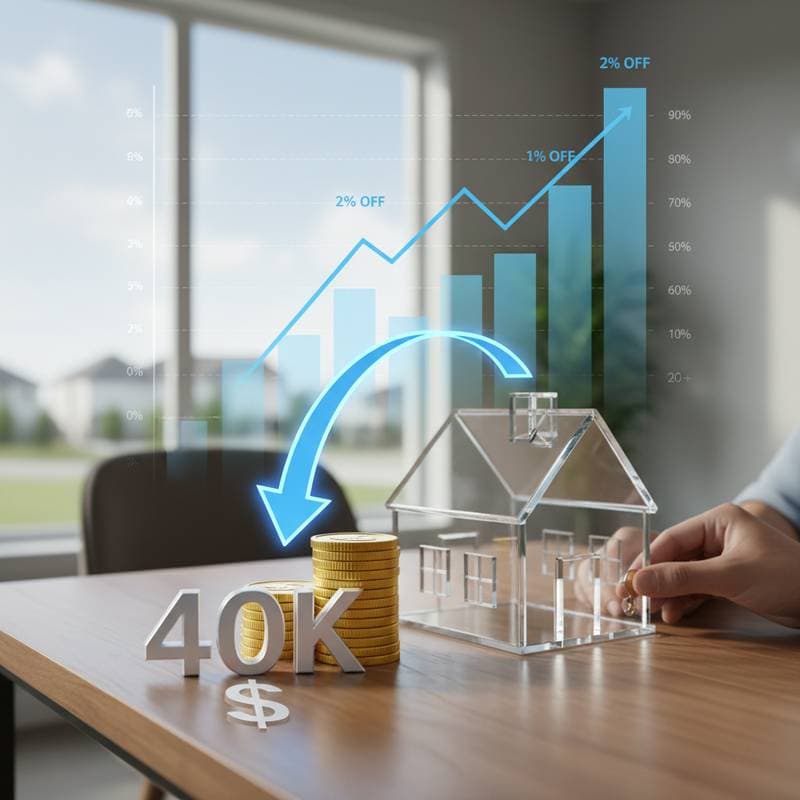Unlock Savings: How a 2-1 Buydown Reduces Mortgage Costs by $40,000
Homebuyers often face the challenge of high interest rates that inflate monthly payments. One effective strategy to mitigate this is the 2-1 buydown, which temporarily reduces the interest rate on a mortgage. This method can lead to substantial savings, potentially amounting to $40,000 over the initial years of the loan.
Consider a scenario where a buyer secures a $300,000 mortgage at a 7% interest rate. Without a buydown, the monthly principal and interest payment might exceed $2,000. The 2-1 buydown adjusts this rate downward for the first two years, easing the transition into homeownership.
This financing tool appeals to those navigating a competitive housing market. It allows individuals to afford a larger home or manage unexpected expenses during the settling-in period. By understanding its mechanics, buyers can make informed decisions that align with their financial goals.
Understanding the Mechanics of a 2-1 Buydown
A 2-1 buydown involves prepaid interest points funded by the seller, builder, or lender to lower the borrower's rate temporarily. In the first year, the interest rate decreases by 2 percentage points below the note rate. The second year sees a 1 percentage point reduction, after which the rate returns to the original level.
For example, on a 30-year fixed mortgage with a 7% note rate, payments in year one would reflect a 5% rate, year two a 6% rate, and years three through thirty the full 7%. This structure requires an upfront payment equivalent to 2-3% of the loan amount, often covered by the seller to sweeten the deal.
Lenders calculate these adjustments based on the loan's principal and term. Buyers benefit from lower initial payments without altering the loan's core terms. This predictability helps in budgeting for home-related costs such as maintenance or property taxes.
Calculating Potential Savings
The savings from a 2-1 buydown depend on the loan size and prevailing rates. For a $400,000 loan at 6.5%, a standard monthly payment might total $2,500. With the buydown, year-one payments drop to approximately $2,000, and year two to $2,250, creating a monthly difference of $500 and $250 respectively.
Over two years, this translates to about $12,000 in direct savings, but the cumulative effect can reach $40,000 when factoring in compounded interest avoidance and potential refinancing opportunities. Larger loans amplify these figures, making the strategy particularly valuable in high-rate environments.
Buyers should request a detailed amortization schedule from their lender to visualize these impacts. Such transparency ensures the buydown aligns with long-term affordability. Professional mortgage advisors can provide personalized projections based on current market conditions.
Determining Suitability for Your Situation
Not every homebuyer benefits equally from a 2-1 buydown. This option suits individuals who anticipate income growth within a few years, allowing them to handle the full rate later without strain. It also fits those planning renovations or major purchases in the home's early stages.
Evaluate your timeline if you intend to refinance. Lower rates in subsequent years could enable a switch to a more favorable loan before the buydown expires. Additionally, if purchasing from a builder or motivated seller, negotiate for them to cover the buydown costs, minimizing your upfront expenses.
- Assess your current budget and future earning potential.
- Review market rate trends for refinancing viability.
- Consult with a lender to estimate total costs and savings.
- Consider your homeownership duration; short-term owners may see limited benefits.
If your finances already operate near capacity, explore alternatives like adjustable-rate mortgages. The key is matching the strategy to your specific circumstances for optimal results.
Negotiating a 2-1 Buydown in Your Purchase
Securing a buydown requires proactive negotiation during the offer process. Start by including a contingency in your purchase agreement that requests seller contributions toward the buydown. Highlight how this concession makes your offer more competitive without reducing the sale price.
Builders often use buydowns as incentives in new construction deals. Approach them early in the selection process to incorporate it into the contract. Lenders may offer partial funding in exchange for a slightly higher note rate, so compare quotes from multiple sources.
Prepare documentation showing your financial stability to strengthen your position. Real estate agents experienced in buyer concessions can guide these discussions. Successful negotiation can offset the buydown's cost entirely, enhancing the deal's value.
Building Long-Term Financial Stability
Beyond immediate savings, a 2-1 buydown fosters confidence in homeownership. It allows focus on establishing roots rather than constant financial worry. Homeowners report greater satisfaction when early payments align with their lifestyle, enabling investments in personalizing their space.
As you adapt to the full rate, use the initial buffer to build an emergency fund or pay down other debts. This proactive approach strengthens overall financial health. The strategy ultimately supports sustainable homeownership, turning a significant life milestone into a manageable reality.
In summary, integrating a 2-1 buydown into your mortgage plan can transform affordability challenges into opportunities. By lowering early payments and providing strategic flexibility, it paves the way for informed, stress-reduced home buying.
